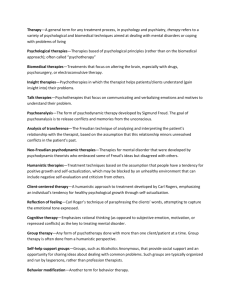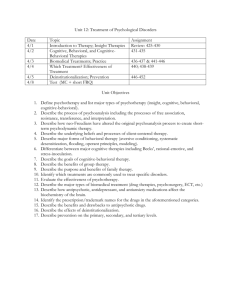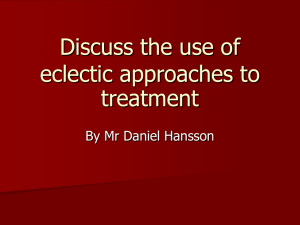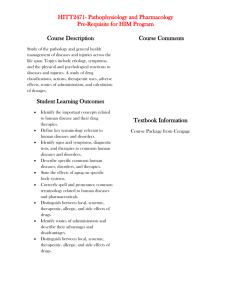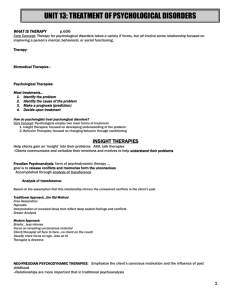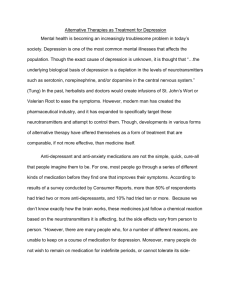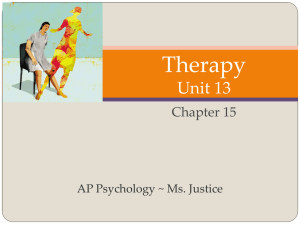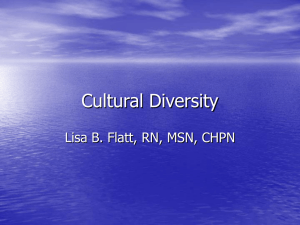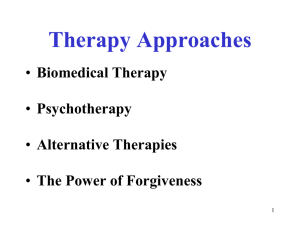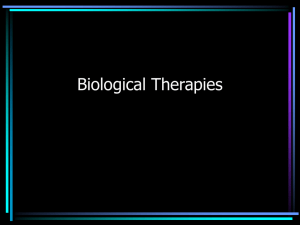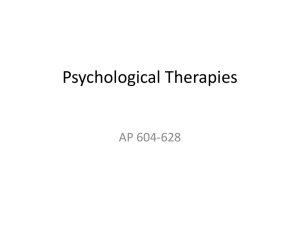Reading Guide_Therapies
advertisement
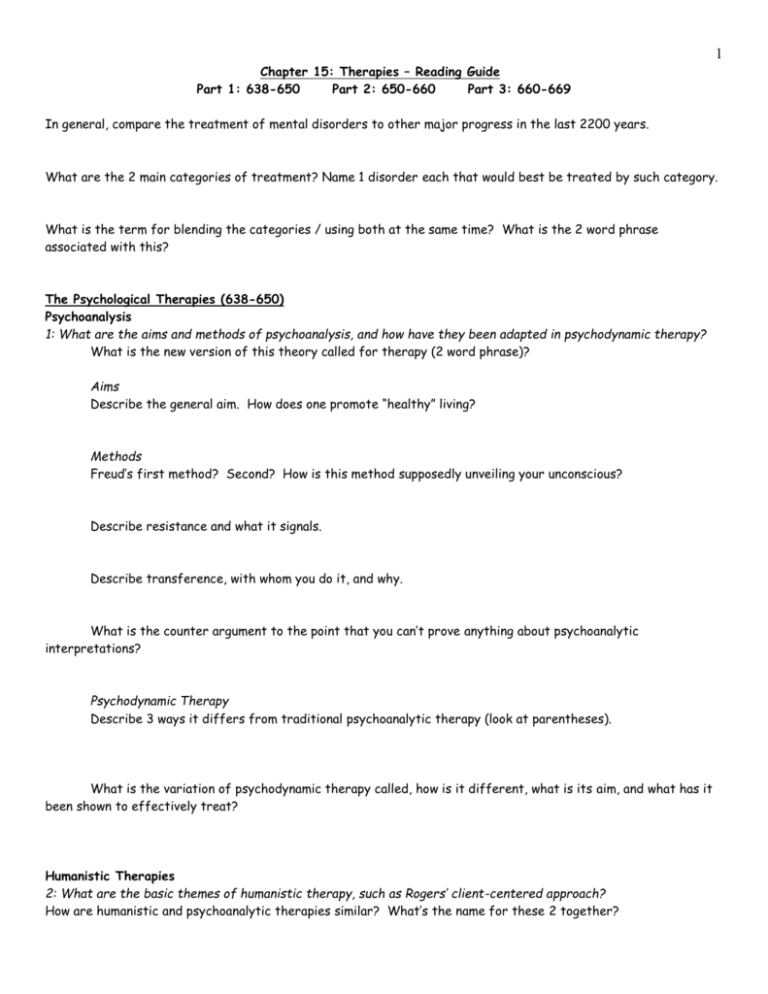
1 Chapter 15: Therapies – Reading Guide Part 1: 638-650 Part 2: 650-660 Part 3: 660-669 In general, compare the treatment of mental disorders to other major progress in the last 2200 years. What are the 2 main categories of treatment? Name 1 disorder each that would best be treated by such category. What is the term for blending the categories / using both at the same time? What is the 2 word phrase associated with this? The Psychological Therapies (638-650) Psychoanalysis 1: What are the aims and methods of psychoanalysis, and how have they been adapted in psychodynamic therapy? What is the new version of this theory called for therapy (2 word phrase)? Aims Describe the general aim. How does one promote “healthy” living? Methods Freud’s first method? Second? How is this method supposedly unveiling your unconscious? Describe resistance and what it signals. Describe transference, with whom you do it, and why. What is the counter argument to the point that you can’t prove anything about psychoanalytic interpretations? Psychodynamic Therapy Describe 3 ways it differs from traditional psychoanalytic therapy (look at parentheses). What is the variation of psychodynamic therapy called, how is it different, what is its aim, and what has it been shown to effectively treat? Humanistic Therapies 2: What are the basic themes of humanistic therapy, such as Rogers’ client-centered approach? How are humanistic and psychoanalytic therapies similar? What’s the name for these 2 together? 2 Summarize 4 ways humanistic therapy is different than psychoanalytic/psychodynamic. a) _________ & ___________ more than the past b) __________ rather than _____________ thoughts c) take _____________ for one’s own feelings & actions, rather than uncover hidden determinants d) promote __________ rather than curing illness. With what type of therapy is Carl Rodgers best associated? Describe how it is nondirective therapy. What 3 traits should therapists exhibit? The “hearing” Rodgers describes is a technique known as _____________________. Paraphrase its definition. Have you ever spoken to your guidance counselor / a therapist? Did they do this with you? Or, have you ever done this while in a conversion with a friend? Explain. Describe the 3 hints to better listening in your own relationships. 1) 2) 3) Behavior Therapies 3: What are the assumptions and techniques of the behavior therapies? Summarize in general how behaviorists would evaluate humanistic therapies. Classical Conditioning Techniques What person should you think of when you think of classical conditioning? (in other words, the CS is classical conditioning and the CR is this person ) Describe O.H. Mowrer’s therapy for bed-wetters. How often does it work? Describe counter-conditioning using the elevator example. Exposure Therapies Describe how Jones’ treatment for Peter is an example of “counter” conditioning. What was Wolpe’s therapy called? Why? Describe progressive relaxation. 3 Another possible method of treatment involving vivid imagery is ____________ Aversive Conditioning – Overall, in this therapy, the therapist helps the client substitute a ________________ response for a ________ response to a ___________ stimulus. Describe an example from the book or a unique one: Describe the successfulness of aversion therapy. Operant Conditioning What 2 word describes the prominent operant conditioning therapy technique? Describe it and an example of how it has been used with autistic individuals (Lovaas, 1987) and the results. What is meant by a token economy? What are the two criticisms of this behavior? Cognitive Therapies 4: What are the goals and techniques of the cognitive therapies? Beck’s Therapy for Depression What was Beck’s original training? How is depression explained by cognitive psychologists? What term is described as “teaching people to restructure their thinking in stressful situations.” What does the therapist (Beck) attempt to demonstrate to the patient regarding her failing a test? Cognitive-Behavior Therapy What disorder was given as an example? How was this used to treat it? Group and Family Therapies 5: What are the aims and benefits of group and family therapy? What is the unique benefit of group therapy? In family therapy, the assumption is that… Thinking question: How might the term “reciprocal determinism” make sense in a family systems theory? How many people does AA have in it? How many Americans belong to a small support group? Evaluating Psychotherapies (650-660) Is Psychotherapy Effective? 6: Does psychotherapy work? Who decides? 4 Clients’ Perceptions What % of Americans were “fairly well satisfied” with their therapy? What are the 3 points regarding skepticism of psychotherapy? Clinicians’ Perceptions What’s the “problem?” THINKING CRITICALLY ABOUT “REGRESSING FROM UNUSUAL TO USUAL” Describe the 2 phenomena. Make sure you understand the 2 nd one! It’s pretty easy, but you better “get it.” Outcome Research What did people think cured typhoid fever? Why? What did Eysenck discover about psychotherapy and its effectiveness? What is meta-analysis and what did it reveal about the effectiveness of psychotherapy (what number)? What is the effect of psychotherapy on some long-term costs? Explain. The Relative Effectiveness of Different Therapies 7: Are some therapies more effective than others? What did Consumer Reports find? When is therapy “most effective?” Explain what this means and/or give examples. What 5 areas are not supported by the research on effective therapy? Evaluating Alternative Therapies 8: How do alternative therapies fare under scientific scrutiny? What percent of those with anxiety problems have sought out “alternative therapy”? Depression? Eye Movement Desensitization and Reprocessing (EMDR) How did Shapiro discover it? Describe it. What percent of single-trauma victims reported it worked? What is the current thought about why it (and other stuff like it) works? 5 Light Exposure Therapy Overall, does it work? Describe. Commonalities among Psychotherapies 9: What three elements are shared by all forms of psychotherapy? Describe the interesting correlation. How strong is it? Hope for Demoralized People What does all therapy offer? A New Perspective How does having a new perspective help? An Empathic, Trusting, and Caring Relationship How were these qualities “found”? What is this bond called? Culture and Values in Psychotherapy 10: How do culture and values influence the therapist-client relationship? Is it important to match clients and therapists on culture/values? Describe. What other area is important? What is Albert Ellis’ therapy called? What do he and Bergin agree upon? Summarize the differences, including their training, among the following mental health professionals: a) counselors b) clinical or psychiatric social workers c) clinical psychologists d) psychiatrists The Biomedical Therapies (660-669) Drug Therapies (when I ask about drugs, use the trade name—generally the shorter one) 11: What are the drug therapies? What criticisms have been leveled against therapies? When were drug therapies discovered? What did they reduce? What is the study of drug effects on mind and behavior called? To evaluate the actual effectiveness of any drug treatment, what research technique must we use? What does this mean? 6 Anti-Psychotic Drugs Positive Symptoms of Schizophrenia: ___________ (trade name = ______________) Most anti-psychotic drugs block __________ receptors. Therefore, overactive _________ system probably contributes to or at least correlates with schizophrenia. Side Effects: resembles the disease ___________, which is under activity of ________. Negative Symptoms of Schizophrenia: ___________ (trade name = ______________) What receptor type does the “one new drug” stimulate? Anti-Anxiety Drugs Examples: _________ & _________ Goal: ___________ central nervous system activity. Don’t combine with __________. What’s the “new antianxiety drug” and how does it work? What disorders might it treat? Anti-Depresssant Drugs Examples: __________, ____________, & ___________ all of which are SSRIs which stands for _________________________________________ and has the result of increasing the amount of serotonin available for the post-synaptic neuron. Goal: Increase availability of 2 NTs: _______________ & _______________ Side Effects: What percent of American women and men today are taking anti-depressants, respectively? One very interesting thing to note and know!: How long must anti-depressants be taken in order for results to be shown? Give a possible explanation for why this is true. What 2 other therapy techniques can be used to treat depression? Compare placebo effects to actual drug effects. Discuss research on the link between anti-depressants and suicide. Mood-Stabilizing Medications What drug is used to treat bipolar disorder mood swings? What percent of people are helped by this? What other drug also works? What was it originally intended to treat? 7 Brain Stimulation 12: How effective is electroconvulsive therapy, and what other brain-stimulation options may offer relief from severe depression? Electroconvulsive Therapy (ECT) When was it first introduced? How many volts!? How is ECT different today? How effective is it? What disorder is it used to treat? What are its side effects? What percent of people relapse within 6 months? Alternative Neurostimulation Therapies What nerve can be stimulated, what area of the brain does it go to, and what is the effect? Magnetic Stimulation What does rTMS stand for and what does it do? What is one thought as to why it works? Deep-Brain Stimulation What might Mayberg have discovered and where? Psychosurgery 13: What is psychosurgey? Define it. Who (and when) discovered lobotomy? Define it. What was it used to treat? What were the personality effects of lobotomies? Therapeutic Life-Style Change 14: How, by caring for their bodies with a healthy life-style, might people find some relief from depression? What is the premise upon which this Ilardi et al.’s (2008) theory is based? Preventing Psychological Disorders (668-669) 15: What is the rationale for preventive mental health programs? What is the “alternative viewpoint?” How does the river analogy apply to mental health?
